Endangered condors illegally killed near Cedar City, Utah

Officials from the Utah Division of Wildlife Resources and the U.S. Fish and Wildlife Service are seeking public assistance in an investigation into the illegal killing of two condors.
The first incident was discovered in 2022, and the second occurred last month. Both birds were shot with firearms near the same location, southeast of Cedar City and north of Zion National Park, according to a statement from the DWR.
The California condor was declared an endangered species in 1967, and by 1982, only 22 condors survived in the wild, according to the California Condor Recovery Program. These remaining condors were captured as part of a breeding program aimed at saving the species.
The California Condor Recovery Program continues to work on increasing the condor population by breeding and releasing them into the wild. Today, the population of wild condors is around 300.
Last year, the population suffered a setback when around 20 condors died in southern Utah and northern Arizona due to a strain of avian flu, per The Associated Press.
“The condor is slow to mature, taking up to eight years before they can produce young, and with an average of one young every other year, the rate of replacement for a loss in the wild is a big impact,” Chris Parrish, president and CEO of the Peregrine Fund, told The Arizona Republic at the time. “Given the total number of birds we eventually lose and the age structure of those lost will have a tremendous impact on the recovery effort, likely to take decades.”
Killing, harming or harassing condors is “a third-degree felony charge of wanton destruction of protected wildlife, with a maximum fine of $5,000, restitution of $1,500 and a five-year prison sentence,” per DWR’s statement.

“The illegal killing of these two condors is a devastating and unnecessary loss on top of all the recent deaths from the highly pathogenic avian influenza,” DWR Avian Conservation Program Coordinator Russell Norvell said. “Between the two events, we’ve lost more than a decade’s worth of progress in the recovery of this species.”
The DWR is offering a possible reward for information leading to the prosecution of the responsible parties. Requests for confidentiality will be respected.
Anyone with information is encouraged to to report it in the following ways:
By calling the UTiP Hotline at 800-662-3337
By texting 847411
By calling the U.S. Fish and Wildlife Service tip line at 844-397-8477
Submitting a tip on the U.S. Fish and Wildlife Service website

